Failure Mode Classification for Rolling Element Bearings Using Time-Domain Transformer-Based Encoder
Abstract
1. Introduction
2. Related Works
3. Method
3.1. Data Cleaning and Denoising
3.2. Transformer Model
4. Validation
4.1. Validation Using IMS Dataset
4.1.1. Description of Dataset
4.1.2. Results and Discussions
- Attention-based model with a simplified structure: Unlike the original design proposed by Vaswani et al. [14], which comprises a full encoder–decoder architecture, we focused on utilizing only the Transformer encoder. We stacked multiple encoder blocks and integrated an MLP layer for classification.
- Implementing a robust adaptive denoising filter: Since different signals may contain varying levels of noise, employing a robust adaptive denoising filter allows for the automatic decomposition and reconstruction of raw data using learnable thresholds.
4.2. Validation Using CWRU Dataset
4.2.1. Dataset Description
4.2.2. Results and Discussions
4.3. Efficiency vs. Accuracy
5. Conclusions and Future Works
Author Contributions
Funding
Institutional Review Board Statement
Informed Consent Statement
Data Availability Statement
Conflicts of Interest
References
- Zhou, H.; Wen, G.; Zhang, Z.; Huang, X.; Dong, S. Sparse dictionary analysis via structure frequency response spectrum model for weak bearing fault diagnosis. Measurement 2021, 174, 109010. [Google Scholar] [CrossRef]
- Lei, Y.; Yang, B.; Jiang, X.; Jia, F.; Li, N.; Nandi, A.K. Applications of machine learning to machine fault diagnosis: A review and roadmap. Mech. Syst. Signal Process. 2020, 138, 106587. [Google Scholar] [CrossRef]
- Ding, Y.; Jia, M.; Miao, Q.; Cao, Y. A novel time–frequency Transformer based on self–attention mechanism and its application in fault diagnosis of rolling bearings. Mech. Syst. Signal Process. 2022, 168, 108616. [Google Scholar] [CrossRef]
- Xu, Z.; Li, C.; Yang, Y. Fault diagnosis of rolling bearing of wind turbines based on the Variational Mode Decomposition and Deep Convolutional Neural Networks. Appl. Soft Comput. 2020, 95, 106515. [Google Scholar] [CrossRef]
- Michau, G.; Chao, M.; Fink, O. Feature Selecting Hierarchical Neural Network for Industrial System Health Monitoring: Catching Informative Features with LASSO. In Proceedings of the 2018 Annual Conference of the Prognostics and Health Management Society (PHM), Philadelphia, PA, USA, 24–27 September 2018; Volume 10, p. 1. [Google Scholar] [CrossRef]
- Li, T.; Zhao, Z.; Sun, C.; Cheng, L.; Chen, X.; Yan, R.; Gao, R. WaveletKernelNet: An Interpretable Deep Neural Network for Industrial Intelligent Diagnosis. IEEE Trans. Syst. Man Cybern. Syst. 2019, 52, 2302–2312. [Google Scholar] [CrossRef]
- Magar, R.; Ghule, L.; Li, J.; Zhao, Y.; Barati Farimani, A. FaultNet: A Deep Convolutional Neural Network for bearing fault classification. IEEE Access 2020, 9, 25189–25199. [Google Scholar] [CrossRef]
- Tan, Z.; Ning, J.; Peng, K.; Xia, Z.; Wu, D. Logistic-ELM: A Novel Fault Diagnosis Method for Rolling Bearings. J. Braz. Soc. Mech. Sci. Eng. 2022, 44, 553. [Google Scholar] [CrossRef]
- Wang, S.; Lian, G.; Cheng, C.; Chen, H. A novel method of rolling bearings fault diagnosis based on singular spectrum decomposition and optimized stochastic configuration network. Neurocomputing 2024, 574, 127278. [Google Scholar] [CrossRef]
- Dai, W.; Liu, J.; Wang, L. Cloud ensemble learning for fault diagnosis of rolling bearings with stochastic configuration networks. Inf. Sci. 2024, 658, 119991. [Google Scholar] [CrossRef]
- Li, H.; Zhang, Z.; Zhang, C. Data augmentation via variational mode reconstruction and its application in few-shot fault diagnosis of rolling bearings. Measurement 2023, 217, 113062. [Google Scholar] [CrossRef]
- Liu, H.; Zhou, J.; Zheng, Y.; Jiang, W.; Zhang, Y. Fault diagnosis of rolling bearings with recurrent neural network-based autoencoders. ISA Trans. 2018, 77, 167–178. [Google Scholar] [CrossRef] [PubMed]
- Zhao, H.; Sun, S.; Jin, B. Sequential Fault Diagnosis Based on LSTM Neural Network. IEEE Access 2018, 6, 12929–12939. [Google Scholar] [CrossRef]
- Vaswani, A.; Shazeer, N.; Parmar, N.; Uszkoreit, J.; Jones, L.; Gomez, A.N.; Kaiser, Ł.; Polosukhin, I. Attention is all you need. Adv. Neural Inf. Process. Syst. 2017, 30, 1–11. [Google Scholar]
- Zhou, H.; Huang, X.; Wen, G.; Dong, S.; Lei, Z.; Zhang, P.; Chen, X. Convolution enabled transformer via random contrastive regularization for rotating machinery diagnosis under time-varying working conditions. Mech. Syst. Signal Process. 2022, 173, 109050. [Google Scholar] [CrossRef]
- Liang, P.; Yu, Z.; Wang, B.; Xu, X.; Tian, J. Fault transfer diagnosis of rolling bearings across multiple working conditions via subdomain adaptation and improved vision transformer network. Adv. Eng. Inform. 2023, 57, 102075. [Google Scholar] [CrossRef]
- Wang, Z.; Xu, Z.; Cai, C.; Wang, X.; Xu, J.; Shi, K.; Zhong, X.; Liao, Z.; Li, Q. Rolling bearing fault diagnosis method using time-frequency information integration and multi-scale TransFusion network. Knowl.-Based Syst. 2024, 284, 111344. [Google Scholar] [CrossRef]
- Mao, W.; Liu, Y.; Ding, L.; Li, Y. Imbalanced Fault Diagnosis of Rolling Bearing Based on Generative Adversarial Network: A Comparative Study. IEEE Access 2019, 7, 9515–9530. [Google Scholar] [CrossRef]
- Xu, G.; Liu, M.; Jiang, Z.; Söffker, D.; Shen, W. Bearing Fault Diagnosis Method Based on Deep Convolutional Neural Network and Random Forest Ensemble Learning. Sensors 2019, 19, 1088. [Google Scholar] [CrossRef] [PubMed]
- Du, J.; Li, X.; Gao, Y.; Gao, L. Integrated Gradient-Based Continuous Wavelet Transform for Bearing Fault Diagnosis. Sensors 2022, 22, 8760. [Google Scholar] [CrossRef]
- Yuan, Y.; Ma, G.; Cheng, C.; Zhou, B.; Zhao, H.; Zhang, H.T.; Ding, H. A general end-to-end diagnosis framework for manufacturing systems. Natl. Sci. Rev. 2019, 7, 418–429. [Google Scholar] [CrossRef]
- Li, X.; Zhang, W.; Ding, Q. A robust intelligent fault diagnosis method for rolling element bearings based on deep distance metric learning. Neurocomputing 2018, 310, 77–95. [Google Scholar] [CrossRef]
- Wang, R.; Jiang, H.; Li, X.; Liu, S. A reinforcement neural architecture search method for rolling bearing fault diagnosis. Measurement 2020, 154, 107417. [Google Scholar] [CrossRef]
- Michau, G.; Frusque, G.; Fink, O. Fully learnable deep wavelet transform for unsupervised monitoring of high-frequency time series. Proc. Natl. Acad. Sci. USA 2022, 119, e2106598119. [Google Scholar] [CrossRef] [PubMed]
- IMS Bearing Dataset. Available online: https://www.nasa.gov/intelligent-systems-division/discovery-and-systems-health/pcoe/pcoe-data-set-repository (accessed on 2 May 2022).
- Case Western Reserve University Bearing Dataset. Available online: https://engineering.case.edu/bearingdatacenter/download-data-file (accessed on 2 May 2022).
- Zhuang, Z.; Lv, H.; Xu, J.; Huang, Z.; Qin, W. A Deep Learning Method for Bearing Fault Diagnosis through Stacked Residual Dilated Convolutions. Appl. Sci. 2019, 9, 1823. [Google Scholar] [CrossRef]

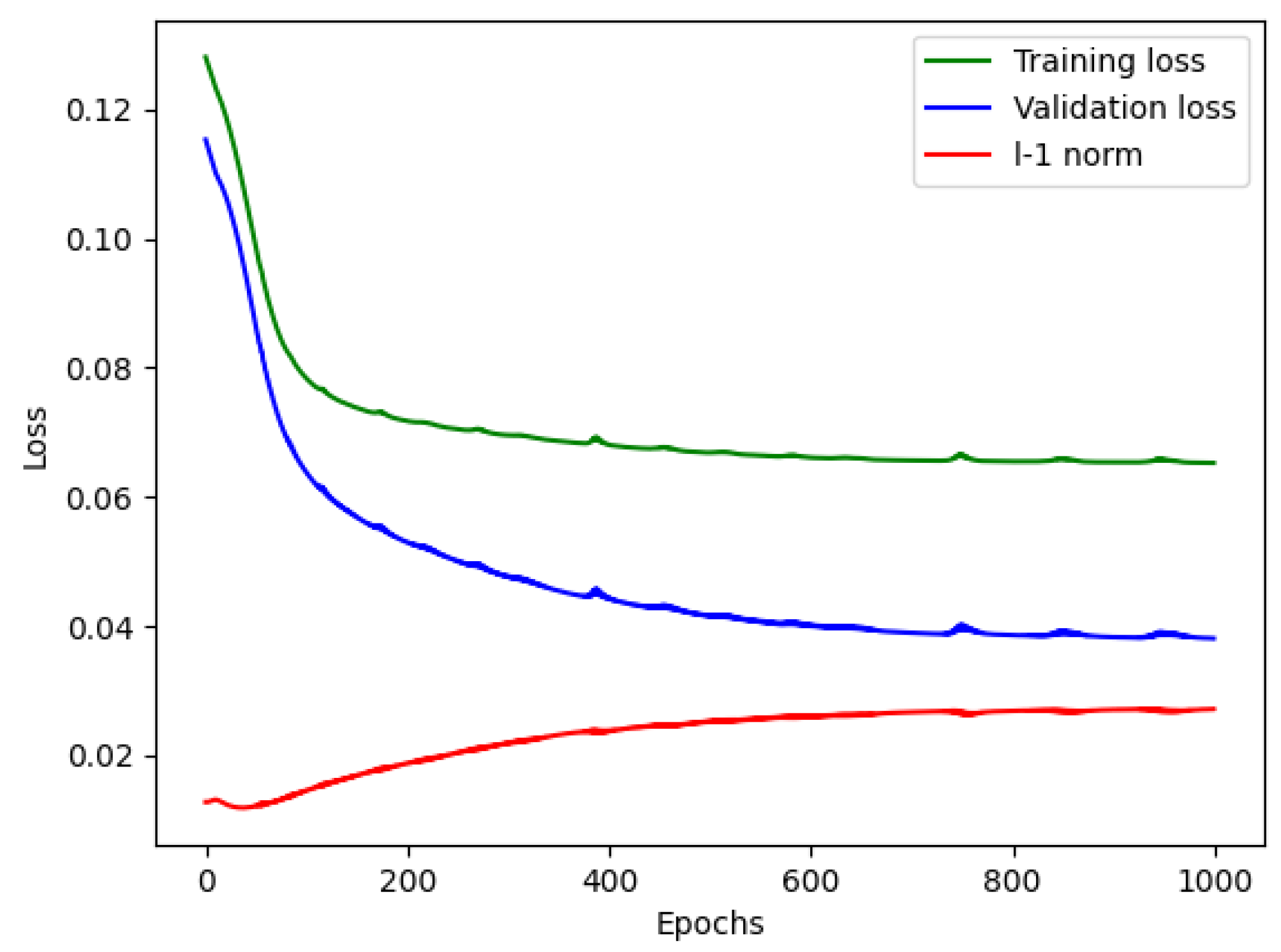
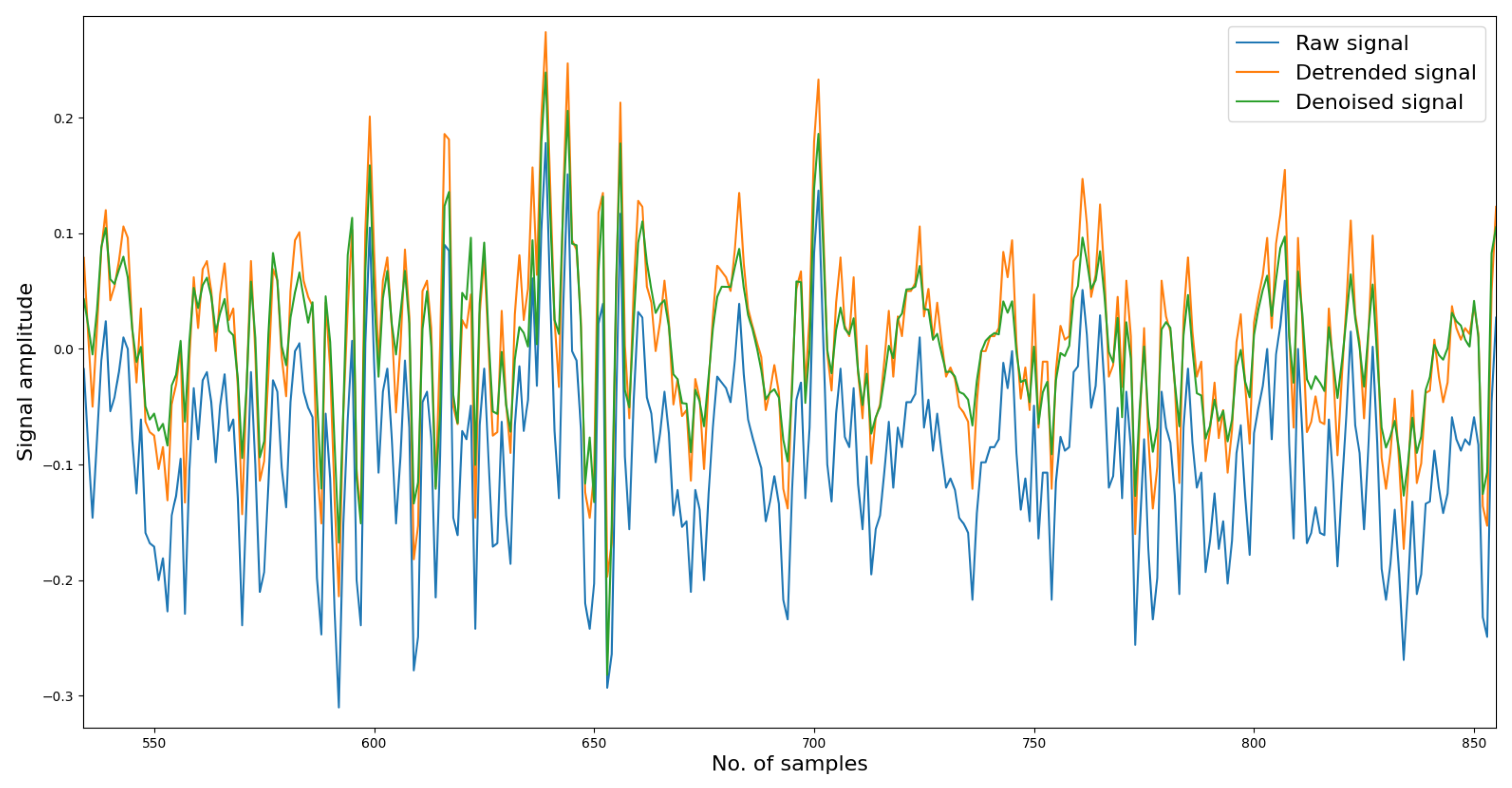
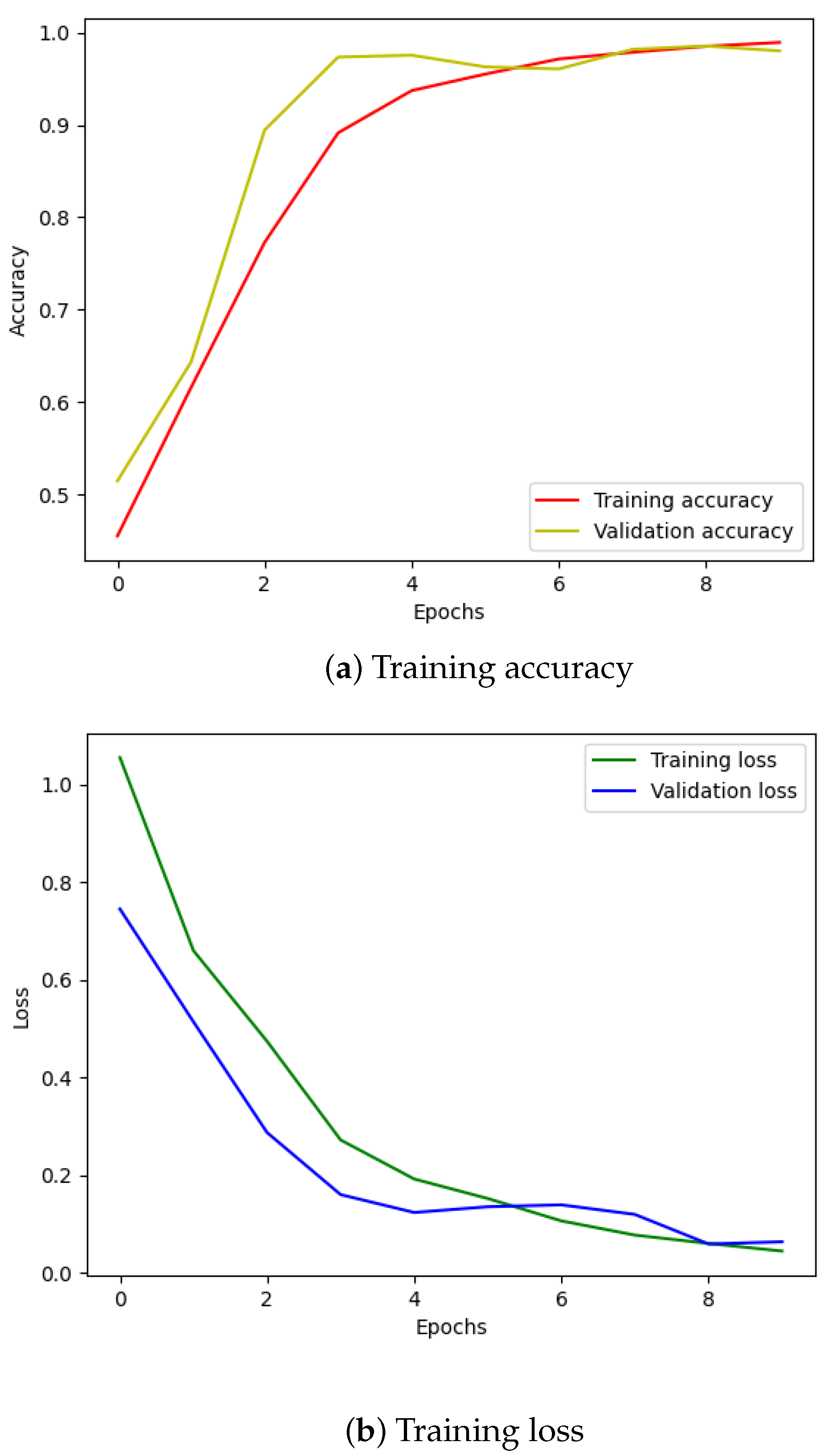

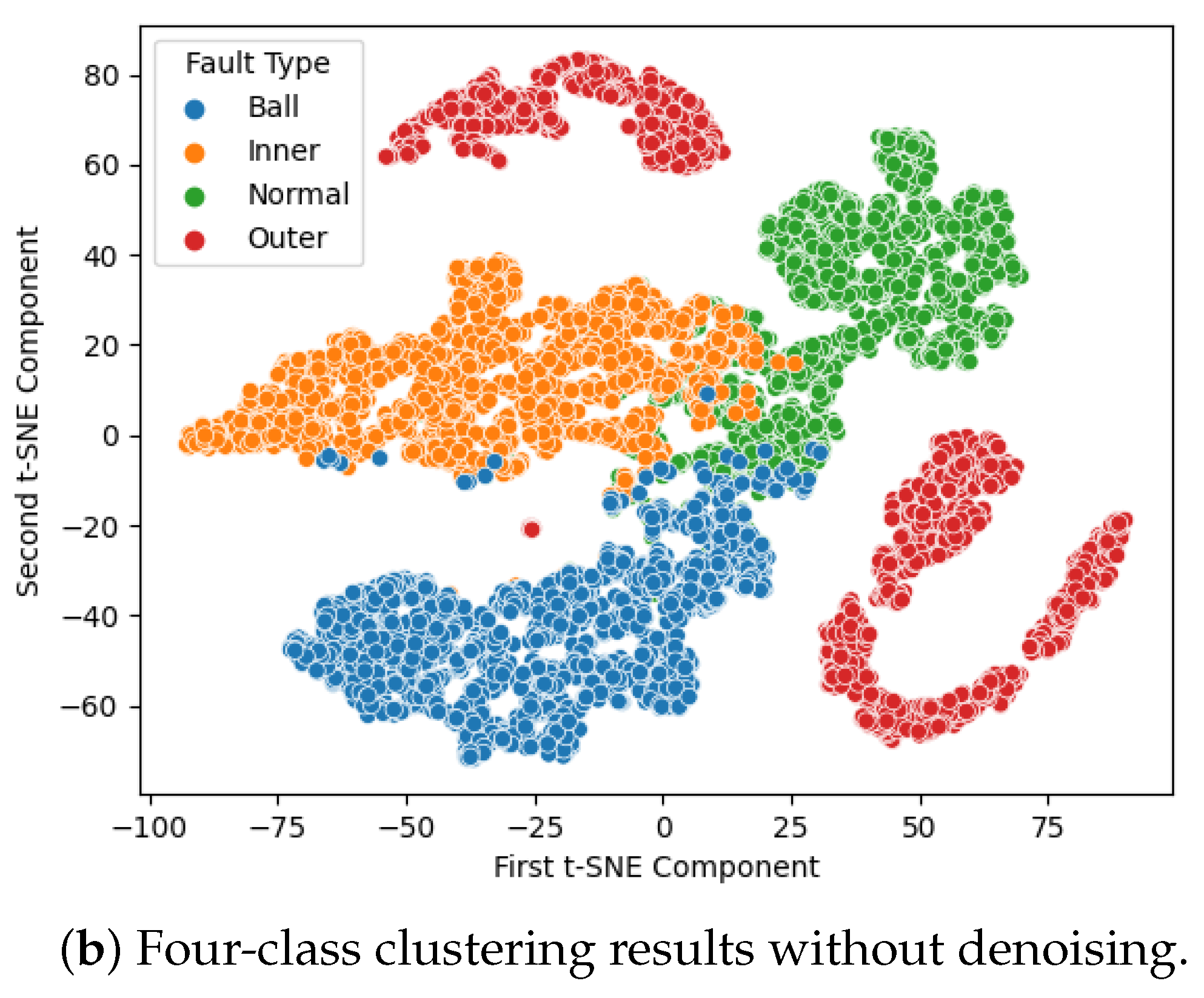



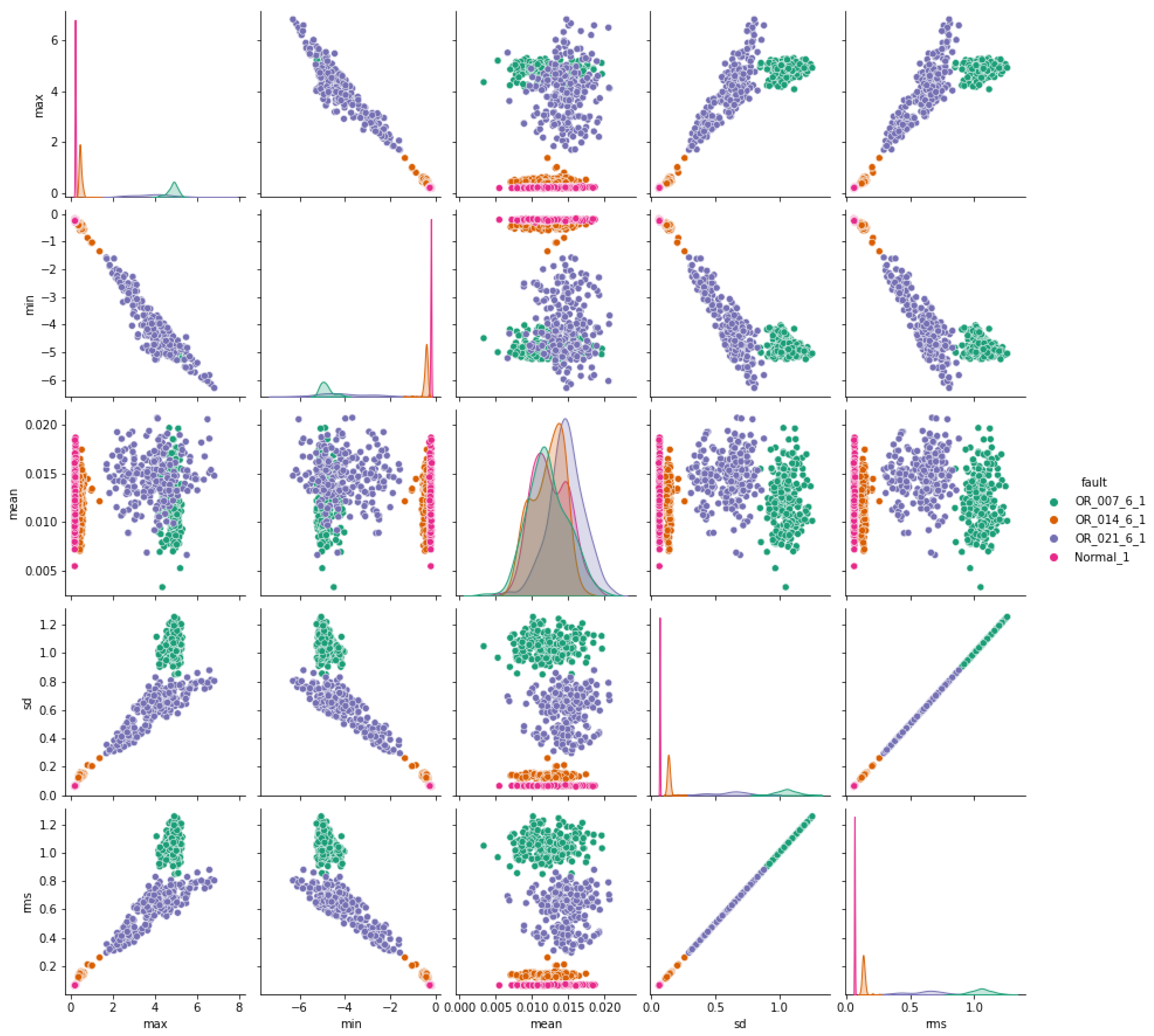
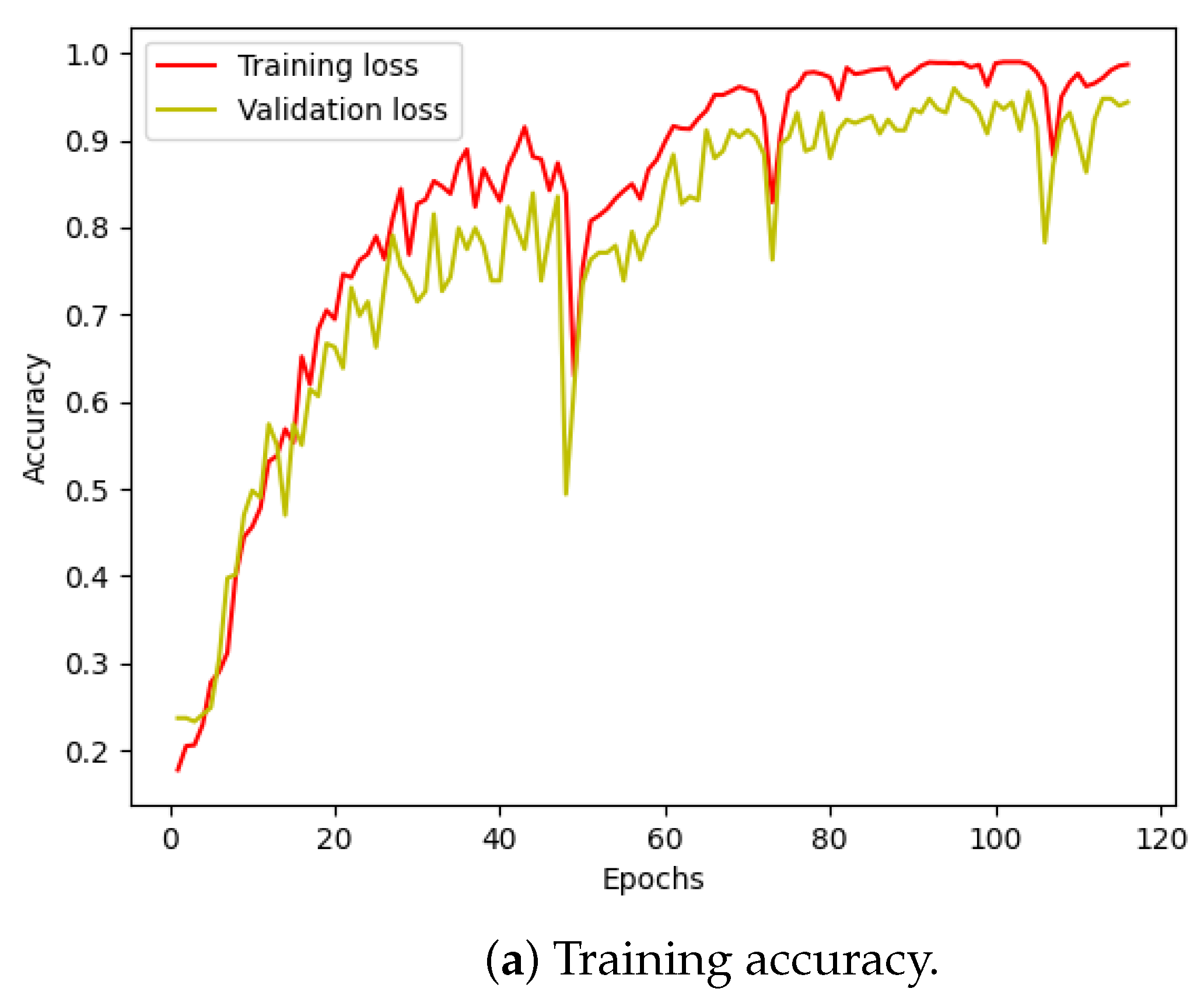
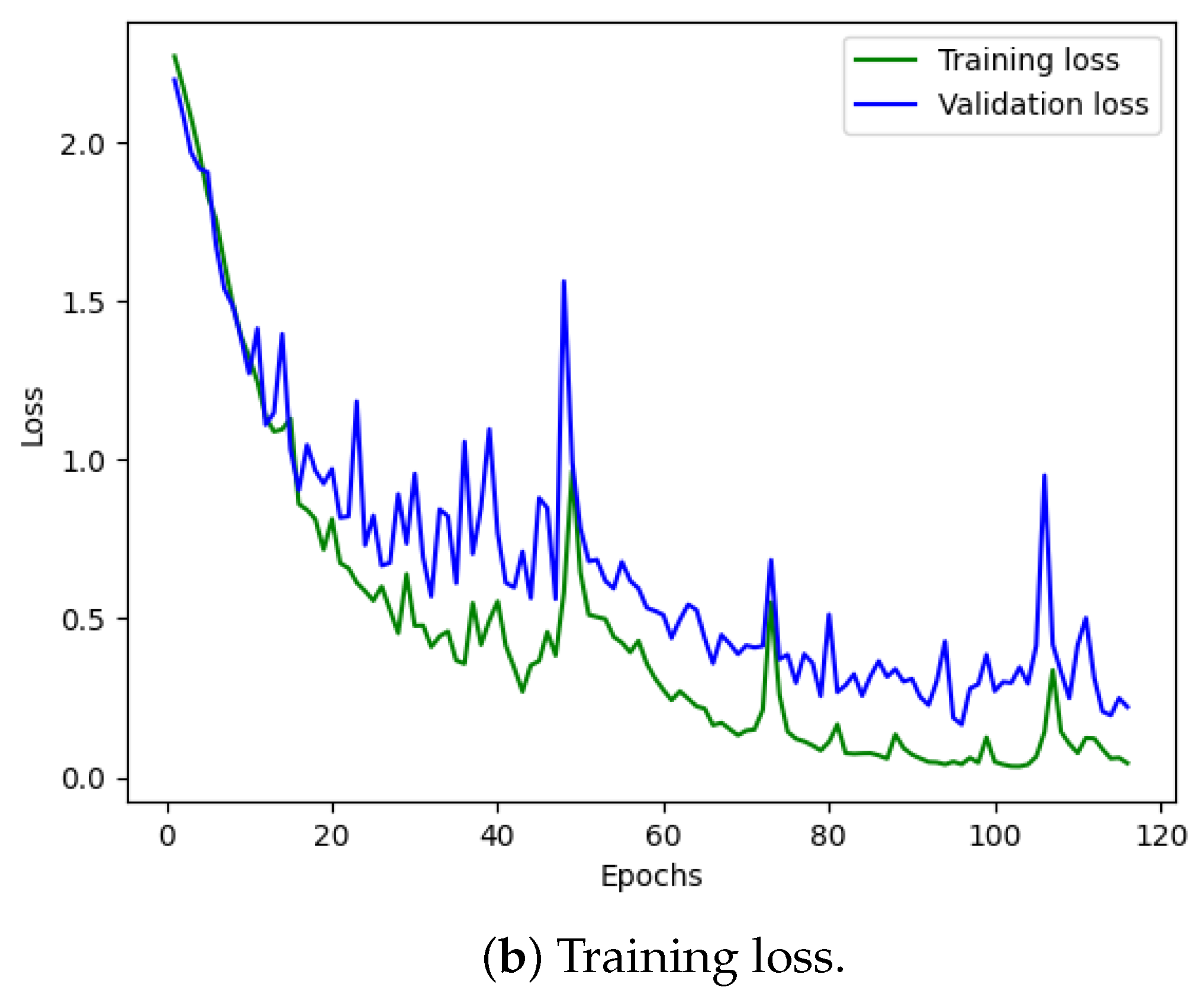
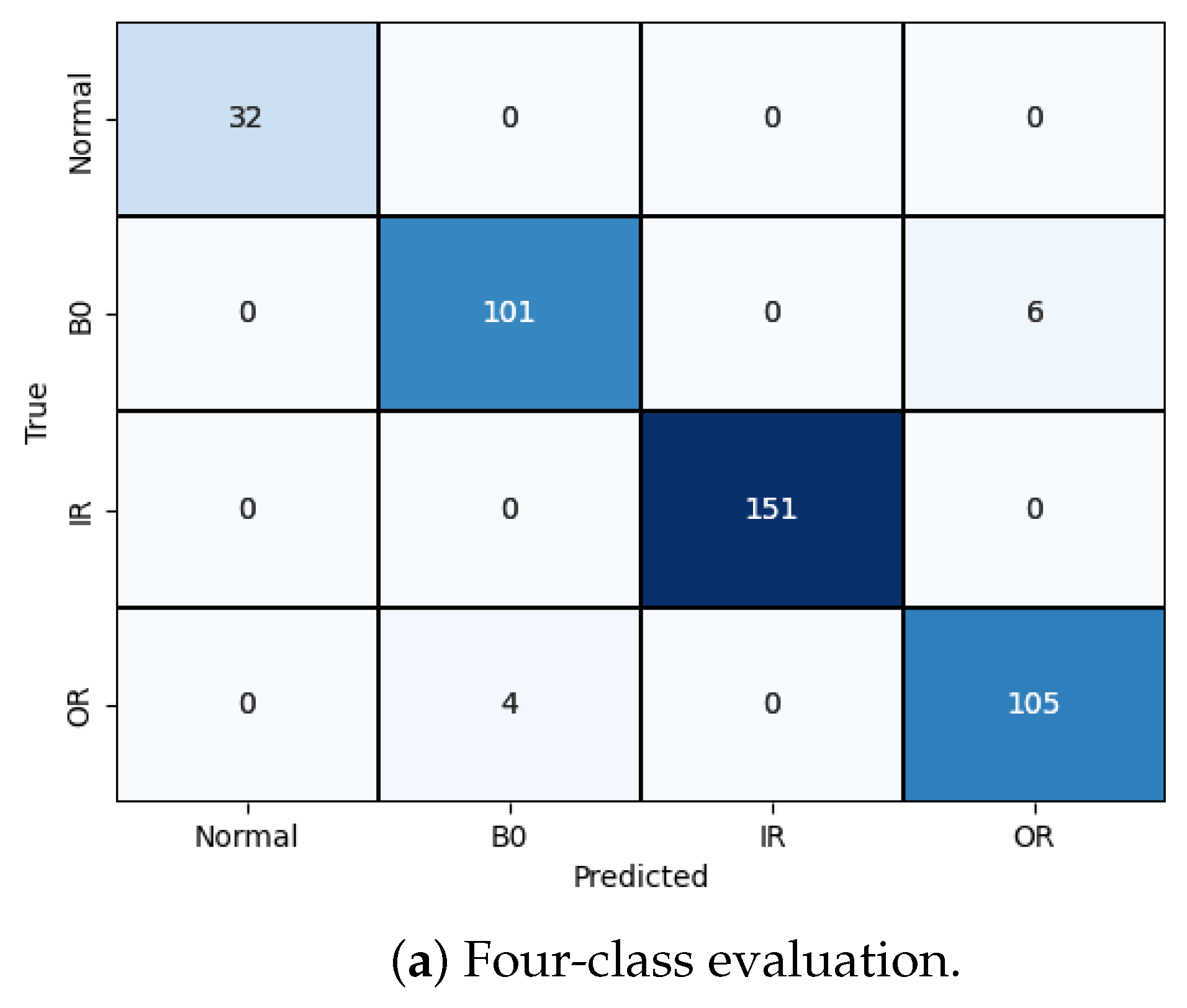
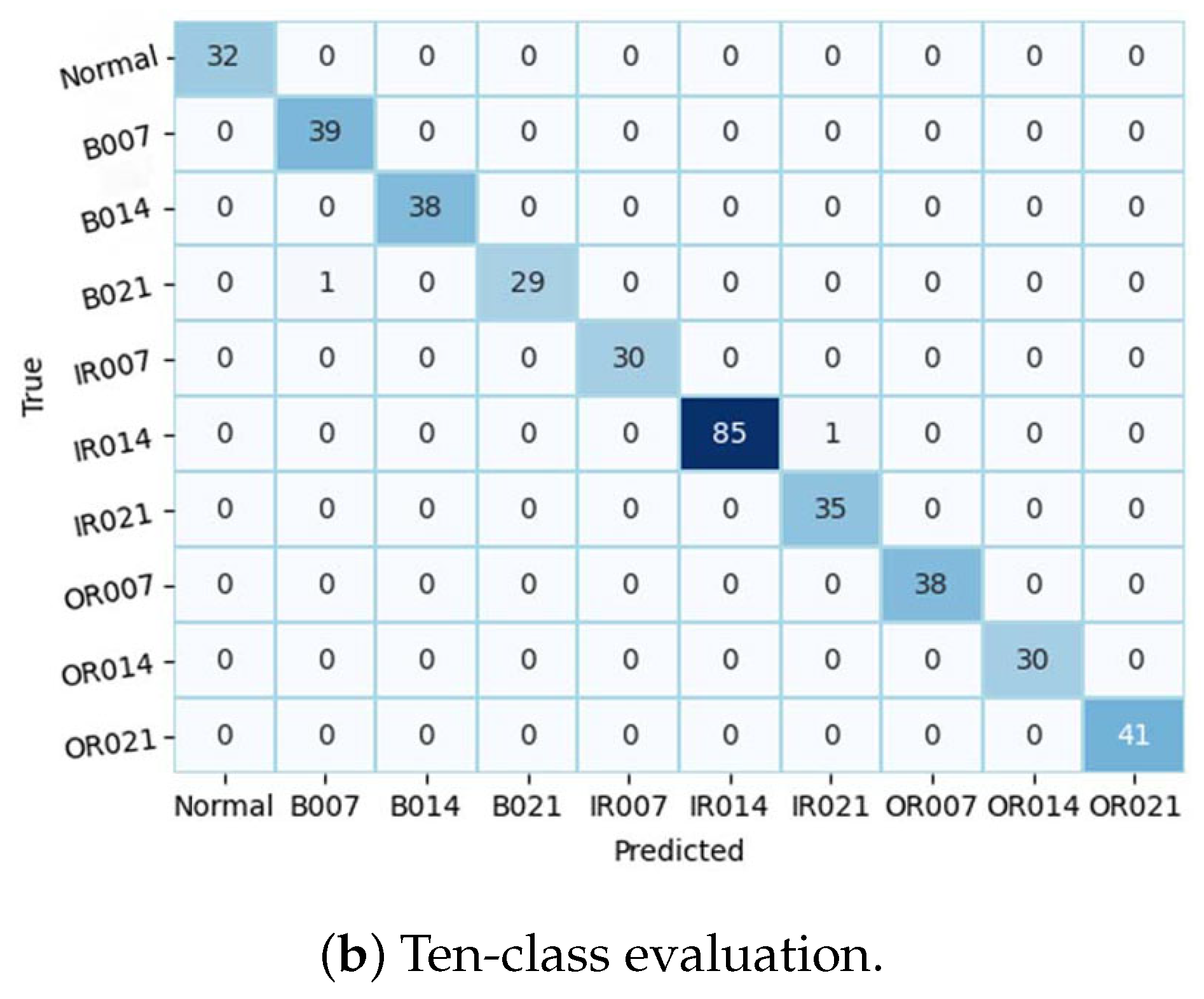

| Properties | Values |
|---|---|
| Sampling Frequency | 20,480 Hz |
| Operating Speed | 2000 RPM |
| Static Loading | 26.7 kN |
| Bore Diameter | 49.2 mm |
| Max Runtime | 34 days 12 h |
| Features | Content |
|---|---|
| Test bench | Motor with 2 HP power |
| Torque transducer | |
| Dynamometer | |
| Control electronics | |
| Diameters of defects in inches (millimeters) | 0.007 inches (0.178 mm) |
| 0.014 (0.356) | |
| 0.021 (0.533) | |
| Telemetry measurements | Drive end (DE) |
| Fan end (FE) | |
| Base (BA) | |
| Conditions | 1 HP load applied to the motor |
| Shaft rotating speed of 1772 rpm | |
| 48 kHz sampling frequency of the accelerometers | |
| Parts of the bearing | Ball |
| Inner race | |
| Outer race |
| Precision | Recall | F1-Score | Support | |
|---|---|---|---|---|
| 0 | 1.00 | 0.97 | 0.98 | 32 |
| 1 | 0.95 | 1.00 | 0.97 | 39 |
| 2 | 1.00 | 1.00 | 1.00 | 38 |
| 3 | 1.00 | 0.97 | 0.98 | 30 |
| 4 | 1.00 | 1.00 | 1.00 | 30 |
| 5 | 1.00 | 1.00 | 1.00 | 86 |
| 6 | 1.00 | 1.00 | 1.00 | 35 |
| 7 | 1.00 | 1.00 | 1.00 | 38 |
| 8 | 1.00 | 0.97 | 0.98 | 30 |
| 9 | 0.98 | 1.00 | 0.99 | 41 |
| Accuracy | 0.99 | 399 | ||
| Macro avg | 0.99 | 0.99 | 0.99 | 399 |
| Weighted avg | 0.99 | 0.99 | 0.99 | 399 |
| Test accuracy | 0.9949874686716792 |
| Precision | Recall | F1-Score | Support | |
|---|---|---|---|---|
| 0 | 1.00 | 1.00 | 1.00 | 32 |
| 1 | 0.99 | 0.99 | 0.99 | 107 |
| 2 | 1.00 | 1.00 | 1.00 | 151 |
| 3 | 0.99 | 0.99 | 0.99 | 109 |
| Accuracy | 0.99 | 399 | ||
| Macro avg | 1.00 | 1.00 | 1.00 | 399 |
| Weighted avg | 0.99 | 0.99 | 0.99 | 399 |
| Test accuracy | 0.974937343358396 |
| Ref. | Results | Remarks |
|---|---|---|
| Our model | 99.5% and 97.5% test accuracy for validation on dataset CWRU with 10-class and 4-class classification, respectively. | Various evaluation metrics are utilized. The model is trained and validated using fixed-window-length data. Despite the training and inference processes each taking several seconds for a sample size of 1024, the model maintains high performance. Incorporating an attention mechanism may enhance explainability. |
| [18] | Model evaluation has 96% accuracy in the test set, 97.96% of F1-score. Performance is verified with various imbalance ratios and parameters when transforming data. | Injecting noise using GAN is tricky when the noise ratio and distribution need to be carefully managed to ensure accuracy and effectiveness. |
| [19] | 99.73% training accuracy for the chosen dataset. | Performance depends on the wavelet family and the number of segmentation samples from the original dataset. The complexity of the assembled model needs to be considered. |
| [21] | 100% training accuracy in all the classes. | Because of the inherent intricacy of the hidden layers, it is challenging to understand how the learnt model works. The data samples are selected and reconstructed from the original data, in which each sample has the same time course. |
| [22] | With 8192 samples, the model’s accuracy was 99.34 percent. | When the sample size is 8192, the training process takes about 40 min on average. |
| [27] | 99.7% accuracy. | Each fault data sample contains the same number of data points, and the sample length is fixed. |
| [23] | 98.47% accuracy in testing. | The number of viable options for building child models is too great, and the research’s scope is too broad. Despite the fact that random actions are generated to prevent local optimal solutions, it is still easy to get stuck in the local ideal solution. |
Disclaimer/Publisher’s Note: The statements, opinions and data contained in all publications are solely those of the individual author(s) and contributor(s) and not of MDPI and/or the editor(s). MDPI and/or the editor(s) disclaim responsibility for any injury to people or property resulting from any ideas, methods, instructions or products referred to in the content. |
© 2024 by the authors. Licensee MDPI, Basel, Switzerland. This article is an open access article distributed under the terms and conditions of the Creative Commons Attribution (CC BY) license (https://creativecommons.org/licenses/by/4.0/).
Share and Cite
Vu, M.T.; Hiraga, M.; Miura, N.; Masuda, A. Failure Mode Classification for Rolling Element Bearings Using Time-Domain Transformer-Based Encoder. Sensors 2024, 24, 3953. https://doi.org/10.3390/s24123953
Vu MT, Hiraga M, Miura N, Masuda A. Failure Mode Classification for Rolling Element Bearings Using Time-Domain Transformer-Based Encoder. Sensors. 2024; 24(12):3953. https://doi.org/10.3390/s24123953
Chicago/Turabian StyleVu, Minh Tri, Motoaki Hiraga, Nanako Miura, and Arata Masuda. 2024. "Failure Mode Classification for Rolling Element Bearings Using Time-Domain Transformer-Based Encoder" Sensors 24, no. 12: 3953. https://doi.org/10.3390/s24123953
APA StyleVu, M. T., Hiraga, M., Miura, N., & Masuda, A. (2024). Failure Mode Classification for Rolling Element Bearings Using Time-Domain Transformer-Based Encoder. Sensors, 24(12), 3953. https://doi.org/10.3390/s24123953





